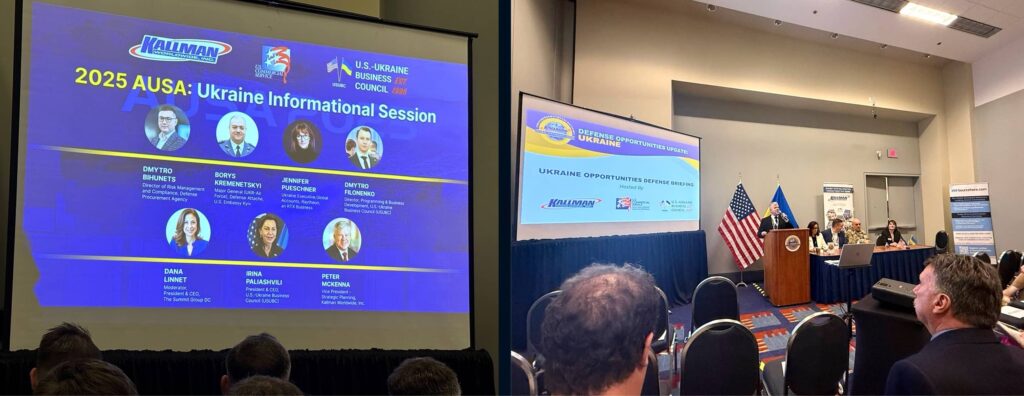Insights from AUSA 2025: How Dignitas Ukraine Connected With the Future of Defense Innovation
Earlier this month, members of the Dignitas Ukraine team – President Dmytro Kavun, Director of Development Yulia O’Connell, and team member Olena Urmey – attended the AUSA Annual Meeting & Exposition in Washington, D.C.

For those unfamiliar, AUSA is the largest land warfare exposition in North America, gathering over 40,000 participants – including global defense leaders, top military officials, and innovators shaping the future of military technology, drones, and defense partnerships.
This year’s event unfolded against a unique backdrop: several key panels were canceled due to the U.S. government shutdown. Yet, despite the challenges, AUSA 2025 offered an impressive display of innovation – and, notably, a rise in drone technologies compared to last year.

The World Is Watching Ukraine
Ukraine’s ongoing war has transformed the way militaries think about modern conflict. At AUSA, Dignitas Ukraine’s team met with defense manufacturers from across Europe and the U.S., many eager to understand and learn from Ukraine’s battlefield-tested innovations.
Some Western companies already have production facilities in Ukraine – a rare but growing trend. They produce FPV drones, interceptor systems, and other unmanned platforms directly informed by real combat experience. For many, the label “Ukraine-tested” has become a powerful badge of credibility – signaling that their technology has proven itself under the most demanding conditions on Earth.
Among the companies Dignitas Ukraine spoke with was Saab Bofors Dynamics, which has supplied significant volumes of military equipment to Ukraine. They also showcased a new signal-reflective fabric designed to make vehicles invisible to thermal, infrared, and radio frequency imaging – a fascinating innovation in stealth materials.

Testing Defense Technologies on Ukraine’s Frontlines
Another important topic raised at AUSA focused on American defense manufacturers who have not yet tested their products in Ukraine. The question came up repeatedly:
Why aren’t you testing in Ukraine?
The answers were often the same. Some companies said they don’t want to send their personnel into an active war zone, while others admitted they fear losing their intellectual property once their technology is deployed in combat conditions. Industry commentary at AUSA echoed these concerns.
At the same time, the Dignitas Ukraine team met several U.S. and European manufacturers eager to test their systems in Ukraine, recognizing that no simulation or lab can replicate the realities of the battlefield.
This growing interest suggests that in the near future, more Western defense companies may begin testing their equipment directly in Ukraine, where innovation meets real-world performance.
At AUSA, defense industry analysts also identified three critical technology areas to watch closely: counter-UAS systems, next-generation power and energy solutions, and AI-driven command, control, and communications (C3). These priorities perfectly mirror Ukraine’s battlefield realities, where constant drone attacks, electronic warfare, and energy resilience are daily challenges.
For many companies, Ukraine’s real-world feedback loop – where innovation is tested and refined under combat conditions – provides invaluable insight for shaping these next-generation defense technologies.
Ukraine’s Voice at AUSA
Thanks to the U.S.-Ukraine Business Council (USUBC), a special panel on Ukraine drew a crowd of about 150 attendees. Dmytro Bihunets from the Defense Procurement Agency of Ukraine presented Ukraine’s evolving defense procurement principles, outlining how the country adapts its processes amid wartime conditions. The panel also featured representatives from the Ukrainian Ministry of Defense, Ukroboronprom (Ukrainian Defense Industry), and the Antonov Company (Design Bureau), who shared insights into Ukraine’s growing defense ecosystem and international partnerships.
A presentation from the British Embassy followed, explaining the UK’s updated defense procurement doctrine known as 20/40/40, emphasizing flexibility and rapid adoption of new technologies – an approach that resonates deeply with Ukraine’s wartime experience.

During this panel, Dignitas Ukraine’s President, Dmytro Kavun, took the stage to introduce the mission of our foundation and highlight how we collaborate with both military and civilian partners to support innovation-driven defense efforts.
How Ukraine Buys and Builds Smarter
One of the most eye-opening discussions centered on how differently Ukraine approaches defense procurement.
While most nations rely solely on centralized government purchasing, Ukrainian military units can submit their own requests directly to manufacturers or volunteer foundations, often bypassing traditional bureaucracy to get what they urgently need, including some heavy equipment.
It’s a decentralized system born out of necessity – and it works. Volunteer organizations like Dignitas Ukraine often play a crucial role in supplying everything from drones to mobile laundry units for troops at the front.
Another fascinating development since the start of russia’s full-scale invasion is the rise of private weapons distributors in Ukraine. These independent actors travel the world seeking and purchasing the specific equipment Ukrainian forces need, then bring it directly into the country.
This phenomenon gives Ukrainian troops more options and faster access to vital supplies, while also demonstrating the flexibility and adaptability of Ukraine’s defense system – one capable of adjusting rapidly to urgent battlefield realities, no matter how complex the circumstances.
Facing the Global Supply Puzzle
A pressing question arose:
Why does Ukraine continue sourcing components from China?
The answer was pragmatic – and revealing. Ukraine has made tremendous progress in producing drones and defense equipment using its own components, but some materials and parts are still unavailable domestically. While there are European alternatives, they are far too expensive to be used as expendable materials in high-turnover systems like drones deployed on the battlefield.
As a result, Ukraine is still forced to purchase certain components from China. Yet China’s role in the defense supply chain is… deeply unbalanced: it allows russia to buy most of what’s available first, leaving Ukraine to access only what remains after russia’s “shopping spree”.
Despite all these obstacles, Ukraine has achieved something remarkable. Ukrainian-made drones are now considered the best in the world in terms of quality-to-cost ratio – a powerful testament to the country’s ingenuity, adaptability, and determination to innovate even under the harshest wartime conditions.
Learning from the Front Lines
Among the panel’s most captivating speakers was Mykola Melnyk, a decorated Ukrainian veteran and Commander in the 47th Brigade. Bringing first-hand combat experience, he explained how specific technologies perform or fail under real battlefield conditions. His insights drew heavy interest from American defense experts and manufacturers alike.
Ukraine’s Central Research Institute of the Armed Forces also shared practical evaluations of various systems, highlighting when and where they deliver the best results – and when they don’t.
A Question Nobody Could Answer
One question sparked quiet reflection in the room:
Why aren’t U.S. forces training in Ukraine to defend against drone attacks?
After all, Ukraine faces round-the-clock drone warfare – offering unparalleled real-world lessons in the tactics that will define future conflicts. Unfortunately, no clear answer was given. But the silence itself spoke volumes: many in the global defense community have yet to fully grasp the scale and nature of this new hybrid, technology-driven warfare.
A Dark and Unexpected Reality
One of the most surprising and unsettling discussions at AUSA touched on a dark and unexpected trend – the presence of members of drug cartels from other countries fighting in Ukraine.
Why, and how, is this even possible?
As it turns out, the explanation is both logical and deeply alarming.
Cartels have been sending their members to Ukraine to fight, allowing them to gain real combat experience, learn military strategies, and acquire tactical knowledge they could never obtain at home. After completing their contracts, these individuals return to their countries with advanced battlefield skills – experience that often exceeds that of regular soldiers in their national armies.
This reality is deeply troubling. It means that criminal organizations are becoming stronger, more sophisticated, and increasingly capable of operating advanced technologies, including multiple types of drones. Their ability to adapt quickly – unlike large institutions weighed down by bureaucracy – allows them to evolve faster, experiment more freely, and apply new combat knowledge with alarming efficiency. This gives them a powerful edge in their illicit activities and poses a growing threat to global security.
The Takeaway
As the panels concluded, one message was crystal clear: tanks no longer define modern warfare – drones and electronic warfare systems do.
This shift was echoed at AUSA, where the U.S. Army introduced its new doctrine, “Transforming in Contact,” – a move toward lighter, more agile brigade formations designed to operate effectively in fast-changing combat environments.
This approach reflects the same lessons Ukraine has already internalized: mobility, adaptability, and real-time innovation now outweigh sheer size or firepower. The wars of the future will favor those who can adapt fastest, not those who are simply the largest.
The battlefield has shifted. Technology, adaptability, and speed now matter more than size or tradition.
We hope that next year’s AUSA will feature a dedicated “Ukraine Pavilion,” where Ukrainian manufacturers of drones, EW systems, and communication technologies can showcase their combat-proven, cost-effective solutions – innovations not just imagined in labs, but forged in real battle for freedom and survival.

Join Us in Supporting Ukraine’s Defense Innovation
Learn more about how Dignitas Ukraine empowers defenders through technology and training. Learn about our FreedomSky initiative or explore Victory Drones to see how your support saves lives on the frontlines.



